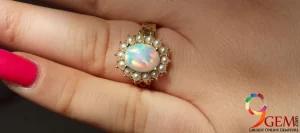 How-To-Care-For-Your-Opal-Jewelry
How-To-Care-For-Your-Opal-Jewelry
A stunning gemstone that demands your attention to keep looking great, opal can last a lifetime if cared for properly. In fact, many people simply love opal gemstone jewelry. If you are one of them and wish to know how can keep this valuable jewelry as good as new for many years, then here’s a complete guide to opal care that you must read and follow.
Understanding Opals:
Opals are unique gemstones prized for their iridescent hues, known as play-of-color. This phenomenon occurs due to the arrangement of microscopic silica spheres within the opal’s structure, diffracting light to produce vibrant colors. Opals come in various types, including precious opal, fire opal, and common opal, each with its distinct characteristics.
Types of Opals:
a. Precious Opal: Exhibits a vivid play-of-color and is highly valued.
b. Fire Opal: Known for its fiery orange to red hues.
c. Common Opal: Lacks play-of-color and is often opaque or translucent.
Opal Varieties:
a. White Opal: Displays a light background with vibrant colors.
b. Black Opal: Features a dark or black background, enhancing color contrast.
c. Boulder Opal: Found in ironstone matrix, creating unique patterns
d. Crystal Opal: Transparent to translucent with exceptional color play.
The Formation, Value, and Significance of Opals
Opals are among the most captivating gemstones in the world, renowned for their kaleidoscopic play of color and ethereal beauty. Beyond their aesthetic appeal, opals hold significant geological and cultural importance.
Formation of Opals:
The formation of opals is a remarkable geological process that occurs over millions of years. Opals are composed of hydrated silica spheres, which are deposited as a gel in rock crevices and cavities. The spheres then gradually solidify to form the intricate structure characteristic of opals.
1. Hydrothermal Processes: Some opals form through hydrothermal processes, where hot water carries silica-rich solutions into rock fissures. As the water cools, silica deposits precipitate, eventually forming opal veins within the host rock.
2. Sedimentary Deposition: In other cases, opals form as sedimentary deposits in ancient riverbeds or shallow marine environments. Over time, silica-rich solutions infiltrate sedimentary layers, creating opalized fossils and nodules.
3. Volcanic Activity: Volcanic activity also plays a role in opal formation, as silica-rich volcanic ash can contribute to the formation of opal deposits. Opals formed in volcanic environments are often known as fire opals, prized for their fiery hues.
The precise conditions required for opal formation, including the presence of silica-rich solutions and suitable host rocks, are relatively rare, making opals a precious and sought-after gemstone.
Value of Opals:
Opals possess a unique charm that sets them apart from other gemstones, leading to their high value in the jewelry market. Several factors contribute to the value of opals, including:
1. Play-of-Color: The most prized opals exhibit a vibrant play-of-color characterized by flashes of iridescent hues that dance across the surface. Opals with strong, vivid color play are considered more valuable than those with subdued or muted colors.
2. Color Spectrum: The diversity of colors present in opals, including red, orange, yellow, green, blue, and violet, contributes to their value. Opals displaying a full spectrum of colors are highly coveted by collectors and connoisseurs.
3. Transparency and Clarity: Transparency and clarity also influence the value of opals, with translucent or transparent specimens commanding higher prices than opaque varieties. Clear, transparent opals allow light to penetrate the stone, enhancing the play-of-color effect.
4. Size and Shape: The size and shape of opals impact their value, with larger stones and rare shapes fetching higher prices. Opals with unique patterns, such as harlequin or pinfire, are particularly prized by collectors for their rarity and aesthetic appeal.
5.Origin: The origin of opals can significantly affect their value, with certain regions renowned for producing high-quality specimens. Australian opals, particularly those from Lightning Ridge and Coober Pedy, are esteemed for their exceptional color play and durability.
6. Rarity and Demand: Ultimately, the rarity of opals and the demand for these gemstones drive their value in the market. Fine-quality opals are relatively scarce compared to other gemstones, making them highly sought-after by collectors and jewelry enthusiasts.
Significance of Opals:
Beyond their intrinsic value as gemstones, opals hold cultural and symbolic significance in various cultures around the world. Throughout history, opals have been revered for their mystical properties and association with love, luck, and protection.
1. Symbol of Love: Opals have long been associated with love and passion, making them popular choices for engagement rings and anniversary gifts. In ancient times, opals were believed to possess the power to intensify emotions and strengthen bonds between loved ones.
2. Talisman of Luck: Opals are often regarded as talismans of luck and good fortune, believed to bring prosperity and happiness to those who wear them. In some cultures, opals are worn as protective amulets to ward off negative energy and evil spirits.
3. Healing Properties: Throughout history, opals have been attributed with various healing properties, including the ability to promote emotional balance, enhance creativity, and stimulate intuition. Opals are also believed to strengthen the connection between the mind, body, and spirit.
4. Birthstone and Zodiac Gem: Opals hold the distinction of being the birthstone for October and the zodiac gemstone for Libra. As such, opals are often chosen as birthday gifts and worn by individuals born under the sign of Libra to harness their celestial energies.
5. Cultural Heritage: Opals feature prominently in the folklore and mythology of many indigenous cultures, where they are revered as sacred symbols of creation and spirituality. In Australia, opals hold special significance to Indigenous Australians, who consider them gifts from the Dreamtime ancestors.
Cleaning Opal Jewelry:
Regular cleaning is crucial to preserve the luster and vibrancy of opal jewelry. However, opals are delicate gemstones that require gentle handling to avoid damage. Here’s how to clean your opal jewelry safely:
1. Use Mild Solutions: Avoid harsh chemicals and abrasive cleaners that can harm opals. Instead, opt for mild solutions such as warm, soapy water or specialized jewelry cleaners formulated for delicate gemstones.
2. Gentle Brushing: Use a soft-bristled brush, such as a toothbrush, to gently remove dirt and grime from the surface of the opal. Avoid scrubbing vigorously, as this may scratch the stone or loosen the settings.
3. Rinse Thoroughly: After cleaning, rinse the opal jewelry under lukewarm water to remove any residue. Ensure all soap or cleaning solutions are completely washed away to prevent dullness.
4. Pat Dry with Soft Cloth: Use a clean, soft cloth to pat the opal jewelry dry gently. Avoid rubbing the stone vigorously, as this can cause friction and potentially damage the surface.
5. Air Dry Naturally: Allow the opal jewelry to air dry naturally before storing it away. Avoid using heat or direct sunlight to speed up the drying process, as excessive heat can cause opals to lose their play of color.
6. Professional Cleaning: For heavily soiled or intricate jewelry pieces, consider seeking professional cleaning services from a reputable jeweler. They have the expertise and tools to clean opal jewelry safely.
Storage and Maintenance:
Proper storage is essential to prevent damage and preserve the beauty of opal jewelry when not in use. Follow these guidelines to ensure your opals remain pristine for years to come:
1. Store Separately: Keep opal jewelry separate from other pieces to prevent scratches and abrasions. Store each item in a soft pouch or lined jewelry box to cushion against impact and friction.
2. Avoid Exposure to Chemicals: Opals are sensitive to chemicals found in household cleaners, cosmetics, and perfumes. Avoid exposing opal jewelry to these substances, as they can cause dullness or discoloration over time.
3. Limit Exposure to Water: While opals are not as porous as some gemstones, prolonged exposure to water can still cause damage. Remove opal jewelry before swimming, showering, or engaging in water-related activities to prevent moisture absorption.
4. Avoid Extreme Temperatures: Opals are sensitive to temperature fluctuations and can crack or craze when exposed to extreme heat or cold. Store opal jewelry in a stable environment away from direct sunlight, heaters, or air conditioning vents.
5. Inspect Regularly: Periodically inspect your opal jewelry for any signs of damage, such as loose settings or cracks in the stone. Promptly address any issues by consulting a professional jeweler to prevent further damage.

